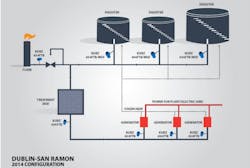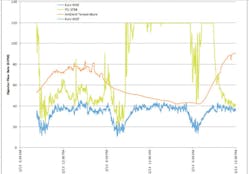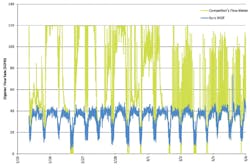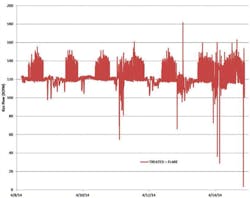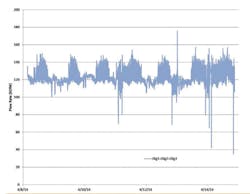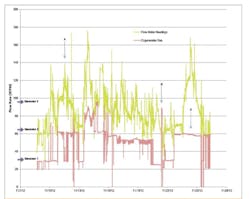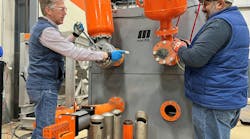Wastewater treatment plants operate 24/7 to meet demand emanating from the consumer, commercial and industrial sectors. Plants follow stringent EPA guidelines, while technology speeds processes that mimic natural water cycles.
The ability to generate biogas from wastewater processes — and issues related to greenhouse gases — has more water-resource facilities recovering biogas. Many plants are able to sell excess energy back to local utilities. Paramount, however, is as little burning-at-the-flare of unused or excess biogas as possible, because that gets reported to air-quality boards.
Accurate measure of gas and other flows is a big part of the processes involved. Some of the lessons learned in three different case examples and discussed herein will interest plant managers both inside and outside of wastewater treatment.
Overview
In wastewater treatment, a digester is simply a huge vessel containing sewage in which chemical or biological processes take place to break down organic material. The process releases biogas, which is captured and used as an energy source.
In wastewater treatment, digester process-management involves balancing sludge quality and quantity with micro-organism health. An imbalance results in poor-quality biogas production, digester upset or foaming.
- Consistent biogas production is essential to operating a modern cogeneration unit. Biogas-fired engines don’t like quality or quantity variation. A shutdown due to fuel-flow interruption is particularly hard on an engine operating at rated power.
- Foaming occurs due to 1) inadequate or inconsistent sludge mixing, 2) feed fluctuations causing acid-forming organisms that compete with biogas-forming microorganisms or 3) imbalance in fats, oils, grease, polymers or dewatering components. At minimum, foaming leads to a digester shut-down and costly clean-up. It could lead to catastrophic failure. Entrained foam can plug flame arrestors and adversely impact level indicators.
Monitoring biogas production is complex. Not only is it affected by sludge and microorganism characteristics, but as a condensing gas, the liquid amounts present vary with daily and seasonal temperature variations.
Warm temperatures reduce condensate amount and droplet size and lead to stable measurement. Cooler temperatures increase both condensate and droplet size, leading to "confusion" for the computers tracking methane production. Excess liquid is recorded as additional biogas, triggering a diversion of methane away from the generator and causing inefficiencies or abrupt shut downs.
Dublin-San Ramon
The Dublin-San Ramon Services District treatment plant serves more than 140,000 residential, commercial, industrial and institutional customers in Dublin, Pleasanton and southern San Ramon, California. Its system supports a strategy bent on increasing use of recycled wastewater.
Resource-recovery efforts include capturing digester gas to generate facility energy. Plant expansions and upgrades include a 1985 capacity increase from 9 to 11.5 million gallons per day (mgd) and up to 17 mgd in 2000.
Three digesters stabilize solids from the 10 mgd average flow generated by the surrounding communities. Biogas captured from the digesters goes to three generators that produce plant electricity. Generator waste heat keeps the digesters warm.
During a plant upgrade, gas-flowmeters were installed to measure the digesters’ biogas production rate. Traditional thermal technology is often used in the wastewater industry, but is known to be deficient in measuring condensing gas flows. At the time of the upgrade, it was recognized that digester measurements reported more biogas production than was being delivered to the cogeneration system due to the variations in condensation caused by temperature changes.
Treated dry gas measurement matched biogas production only during the day’s heat. How temperature changes, especially cold weather, affected condensation levels and flow measurements was unclear.
Proven test case
Based on an offer from the supplier, the Dublin-San Ramon plant was used as a test site for new biogas instrumentation. Aware of the measuring issues discussed above, Kurz Instruments had developed a solution that works by effectively ignoring the liquid condensate.
Preliminary results showed impressive improvement. The test was expanded to all raw biogas ports. The expectation was that expanding the test would validate the long-standing discrepancy between gas production and gas consumption.
One of the first comparison tests on Digester 1 showed that in the early mornings and in the evenings, flowmeters reported false high readings and took more time to respond to digester changes in cooler weather. As exterior temperatures rise, the flowmeter readings come closer to agreement.
A week’s worth of data indicated that digester dosing — i.e., the rate of sludge feeding — was consistent, the original flowmeter erratic, and its replacement accurate.
The SCADA system summed data of all three digesters over the course of a year. The resulting graph clearly showed gas-production over-reporting was related to seasonal changes in ambient temperature, with at times almost twice as much gas production being reported as was being consumed.
Within the last year, a Kurz WGF flowmeter was installed on each digester. The graph on the left shows the sum of the three digesters related to sludge collection. The graph on the right shows the sum of gas consumption sent to the cogeneration engines and flare. The short spikes in the consumption graph for the 20-30 SCFM range are caused by the flare control scheme for biogas pressure above 15 inches of H2O. As anticipated, total biogas production now closely matches biogas consumption.
Instrumentation appropriate to condensing gas flow resolved the long-standing discrepancy between gas measurement and actual energy recovery. Moreover, individual digester data revealed a cyclical production pattern created by the sludge-doser timer setting. The flowmeters indicated how digester-gas output responded to sludge-feeding input, leading to better management and control.
Digester flowmeters appropriate for condensing gas applications allow the plant to accurately monitor biogas production at all condensation levels. The Kurz WGF flowmeter ignores liquid droplets and reports the true dry-gas flow rate.
San Leandro
The San Leandro Water Pollution Control Plant serves more than 50,000 residents, in addition to businesses, commercial and industrial customers for the northern two-thirds of San Leandro. Its prime directives include protecting San Francisco Bay while serving the community.
The plant’s three digesters treat solids from a 5.0 mgd flow.
Extensive renovations include a $50-million upgrade to support a maximum dry-weather flow capacity of 7.6 mgd and spikes up to 23 mgd. Treatment removes approximately 6.0 million pounds of solids from wastewater each year.
San Leandro produces heat from three 110kW cogenerators fueled by three digesters. The plant also has a FOG (fats, oils and grease) receiving station that ensures these materials are not poured into drains. The fats, oils and grease collected are used in one of the digesters.
San Leandro’s cogeneration system was specified for heat and electricity generation performance based on gas production. All parties involved have a vested interest in accurate measurements.
In addition, management realized that gas-flow fluctuation caused havoc with the cogeneration system due to unsteady generator performance.
Removing ambiguity
Overall digester health and stability were monitored by testing volatile acids-to-alkalinity ratios, pH, and biogas and CO2 percentages. While the tests provide basic monitoring for a specific time of day, unanticipated changes in sludge quantity or content created imbalances.
While community use is typically within expected seasonal ranges, sewage levels vary from local milk-product and soda-bottling facilities. The biochemical oxygen demand (BOD) of this sewage is high (450 mg/l) and results in highly variable day-to-day gas production.
The biogas’ ratio of CH4 and CO2 is 65 percent and 35 percent, respectively. To come on-line, each cogenerator requires its own gas feed of approximately 32 scfm of biogas.
Mismatch in biogas readings and questions about flowmeter accuracy resulted in the cogenerators remaining off despite sufficient fuel (A and C), and being turned on despite insufficient fuel (B). Generators shut down due to loss of gas pressure even though the biogas flow remained sufficient. With the generator offline, gas pressure would build up and biogas redirected to the flare. It was recognized better monitoring would eliminate costly cogenerator stops and starts.
A Kurz WGF flowmeter on the digester and additional flare and cogenerator flowmeters more accurately track gas production and consumption, as well as system integrity. Cogeneration control is more accurate and performance steadier. Gas production from FOG dosing is quick and fairly predictable; making it practical to install a pump feed control system so the cogenerators can stay above the minimum gas requirements. This maximizes energy recovery, minimizes potential flaring and reduces potential fines.
A flowmeter that rapidly responds to changing biogas levels provides the best indicator of digester health. Varying condensation levels cause most thermal flowmeters to errantly over-report biogas production. The wrong information can lead to bad decisions. The replacement flowmeters removed ambiguity from the recorded gas flows and eliminated false spikes and drops.
Inland Empire
The Inland Empire Utilities Agency (IEUA) operates and maintains four water-recycling and two bio-solids treatment facilities. The four facilities reclaim wastewater from the five member agencies with total combined design treatment capacity of 84 mgd.
Regional water recycling plant no. 1 (RP-1) in Ontario, California, was originally commissioned in 1948. Several expansions increased treatment capacity to 44 mgd and biosolids treatment capacity to the equivalent of a 60 mgd wastewater flow rate. Major treatment processes include preliminary and primary treatment, primary effluent flow equalization and diversion, and secondary, tertiary and biosolids treatment.
Since 2000, RP-1 uses multistage anaerobic digestion to improve facility efficiency, separating a single digester process into temperature-based anaerobic digestion phases using multiple digesters: RP-1 first-stage digesters operate at 90 F – 104 F, second-stage at 122 F – 127 F and third-stage at 108 F – 110 F.
IEUA technical staff believed an acid-phase upset was partially attributable to the thermal flowmeters’ inability to respond effectively to changing gas production when impacted by liquid condensation from the digester.
After testing a Kurz WGF for one month, operators questioned what appeared to be noise generated by the new flowmeter. After several experiments, it was determined that the meter was actually measuring gas burping through the scum-mat floating on the digester. This demonstrated the responsive measurement capabilities of the Kurz WGF.
The next occurred when operators prevented an upset due to vivianite buildup in the heat exchanger. As digester temperature began dropping, gas production was immediately affected. Flowmeter fast response time allowed taking corrective action to prevent a situation that would have otherwise required extensive maintenance and cleanup. The previous thermal flowmeters would not have recognized the rapidly changing gas-production profile.
Final words
Dublin-San Ramon, San Leandro and Inland Empire all recognized the benefits of using digester gas. But the efficacy of their investments was thwarted by poor gas-flow instrumentation. Each plant’s issue was different but all were solved by the right instrumentation.
The Kurz WGF flowmeter is a low-cost alternative to other condensing-gas flowmeter technologies. Its ability to provide a consistent dry gas flow regardless of varying levels of liquid makes it unique. To do so it operates at an overheat that vaporizes any droplets contacting the sensor. This allows a quick response for true dry gas flow measurement within a condensing gas environment.
Other thermal meters specified for condensing-gas environments have a sensor overheat incapable of stopping droplet contact with the sensor, which then requires substantial time to dry out. The varying degrees of continuous condensation make it impossible for other thermal meters to retain accuracy in digester applications.
In addition to having a flowmeter indicating digester health and gas production on each digester, a flowmeter at each generator and at the flare allows a plant to match biogas production at the digester with biogas use at the generators and waste flare. Imbalance amongst the three is an immediate indicator that there is systemic imbalance, such as might be caused by a leak or blockage, so that corrective action might be indicated.
At end of day, what you want to see is efficient biogas use, improved systems, reduced flaring, an end to venting and accurate measures that ensure regulatory compliance.
Kurz Instruments Inc.
